New Car Review Of The 2004 Toyota Prius Mid-Size Hybrid Sedan
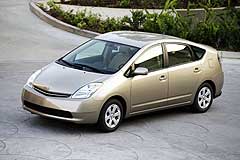
Base MSRP Range: $19,995
Base Invoice Range: $18,411
MSRP As Tested: Not Available
Versions: Sedan
Vehicle Category: Mid-Size Sedan
Engine Location: Front Engine
Drive Wheels: Front-Wheel Drive.
Engine As Tested: 1.5-liter, Gas/Electric Hybrid, Dual Overhead Cam, 16-valves, I-4 cylinder, 76-horsepower at 5,000rpm and 82 lb-ft torque at 4,200 rpm.
Transmission As Tested: Standard Continuously Variable, 6-speed Automatic.
Fuel Economy (city/hwy): CVT automatic 51/60
Standard Safety Features: Driver and front passenger airbags, power-assisted disc brakes, ">Antilock Braking System (ABS).
Competition: Honda Civic Hybrid.
Review
Vehicle History
The Prius went on sale in Japan in 1997. It was the first mass-produced, gas-electric, hybrid-fuel vehicle available worldwide. 3 years later, in August 2000, the Prius was introduced in the Untied States. It was Toyota’s second-generation product. That year Toyota sold 5,600 of the cars. 2002 was the last year of the current model run, and in that year over 20,000 were sold.
The car was revolutionary. General Motors had experimented with electric cars but its EV1 met with little success due to technical limitations. Toyota, Honda and Ford took different product development approaches. They believed that, for the immediate future, gas-electric, hybrid-fuel powered vehicles were the shortest route to production cars that were both cleaner running and affordable to own. They believed only eco cars that performed as well as traditional cars, and cost no more to own and operate, would be successful with the American public.
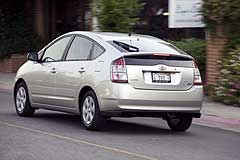
The Prius originally introduced in the U.S. had 2 motors, a conventional 4-cylinder, gasoline-powered engine, and an electric motor. The electric motor drove the car most of the time. When the batteries were low or more power needed to accelerate onto a freeway or climb a hill, the gasoline engine would take over. When the car idled, or was stopped at a stoplight, the gasoline engine shut off. A device on the brakes provided the predominant means of recharging the battery. Plugging into a wall socket, recharging station, or paying a large energy bill was unnecessary. This tactic left fewer standards to meet. All in all the second Prius got a whopping 48 gas-miserly miles to a gallon of gas; a humungous improvement.
Unlike the Honda Insight, the Prius had room for 4 adults, and 5 if the person in the middle of the back seat was small. It had a trunk that could carry a normal load for a small sedan. It was functional, short on power, odd looking, and built with too many cheap parts. Not a lot to overcome in a third model.
Toyota has introduced a new Prius for 2004. This one signals the arrival of a nearly-mature, gas-electric, hybrid car that is economical on all fronts, and functional for the masses. It is larger, faster, gets better fuel economy, and is more commodious and comfortable than the car it replaces. The car grows in size moving it from the compact to the mid-size segment. With part quality and interior space to rival mainstream cars like Accord, Camry, and Taurus there are now few reasons not to have Prius on your immediate test-drive list.
Exterior Styling
Although considerably better looking than the previous car, the new Prius is still a bit odd. However that strangeness works both for, and against, the car. The Prius is a fundamentally different product than the standard-gas-powered-soot-blowers most people drive. Because of this some designers think it needs to look different. More importantly the shape of the vehicle is intrinsic to miserly gas consumption. We believe in order for it to sell like mainstream cars it needs to have a style people want to own, and styling will undoubtedly evolve over time. Moreover Prius is already competing with the Honda Civic, and the-shortly-to-be released Lexus RX330 Hybrid, thus mainstream looks are going to be critical to the success of the product.
The 2004 Prius is a much larger car than the one it replaces. The wheelbase is a full 6 inches longer.
The new Prius maintains the rounded, aerodynamic shape that gives the car a super-low, 0.26 coefficient of drag (Cd). The low Cd decreases the effect air mass has on the vehicle enabling the car to slide through air rather than ram into it. The design is a critical component of maximizing fuel consumption, and minimizing interior noise. The hood rises up into the A pillar curving over the passenger compartment into the D pillar at the very back of the car. The shape is an elongated arch.
The only drawback we encountered is that rearward visibility is significantly hindered by the rear deck, which cuts across the window.
Interior Styling
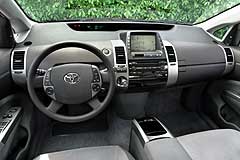
The new Prius has a refined version of the space-age interior in the previous model. The instrument panel (IP) is round and centered along the top of the dashboard, instead of directly in front of the driver. It contains a thin computer display with digital readout for the speedometer, fuel and other gauges, and warning lights. The large Multi-Information Display provides status data on electric power usage and regeneration, and controls for the air conditioning, climate controls, and the Deluxe AM/FM/CD Sound System. The display is also used by the optional navigation and hands-free communication systems. Prius uses Bluetooth technology to communicate with the driver’s cell phone, if properly equipped.
Below the Multi-Information Display are the CD and Cassette decks, and the transmission selector.
The Prius is a very comfortable car given its price. The steering wheel is solid giving the driver a sense of control. The seats are supportive and made of quality fabric devoid of silly patterns that look outdated as soon as they are released, and only make economy cars look cheap. The most important aspect of the interior is that the seats are comfortable and not fatiguing as were those in the previous model. Rear seat room is very good. 4 adults can ride comfortably in a Prius for a good long distance in comfort.
Prius comes standard with many comfort and convenience features -- which are optional on more expensive cars. These include Cabin Filtration (so you don’t choke on the exhaust coming from the Chevy Suburban you are stuck behind in traffic), cruise control (for when you finally do get out of traffic), power windows and door locks, and even remote keyless entry.
An option on the Prius, that is generally only available on cars costing twice as much, is a Smart Entry and Start Option. This allows for hands-free entry and startup of the car. With the key fob in your pocket, or purse, pull on the door handle. An on-board sensor detects the key, and unlocks the door. Once inside just push the start button, select the gear you need, and you’re off. Not only is this convenient, but it is an important personal safety feature especially for people who are in parking lots or buildings at night.
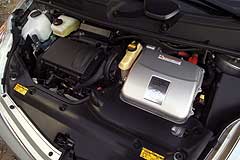
Engine Performance
The 2004 Prius is powered by Toyota’s new Hybrid Synergy Drive system. Toyota describes it as a “full hybrid system” capable of operating in either gas, or electric mode. It also has a third a mode that combines both electric and gas power.
Prius’ Hybrid Synergy Drive consists of a 1.5-liter gasoline engine with a piggybacked electric motor. The gasoline engine delivers 76-horsepower, 6 more than the engine, and 82 lb-ft of torque. Like all other Toyota passenger car engines, Variable Valve Timing with Intelligence optimizes power across the engine’s rev range. The electric motor produces its maximum power, 50kW which equates to 67-horsepower, from 1,200 to 1,540 RPM with a peak torque of 295 lb-ft.
Mileage (which is why most people will buy the Prius as opposed to the level of emissions it produces) has been confirmed by the Environmental Protection Agency (EPA) at 60/highway, 51/city for a combined 55 miles per gallon. We have heard that in real-world use the numbers are not as high as the EPA quotes. Regardless if you receive a real-world performance and get 48 miles to the gallon as we hear is standard for the product you will still have much lower fuel costs than your neighbors driving traditional economy cars.
The 2004 Prius is no rocket by any stretch of the imagination. But the power is more than adequate for urban commuting, highway travel (once up to speed), and all those weekly short trips around town to keep the homestead supplied and the kids arriving on time for soccer. You won’t win races, but you will stop more than half as often for gas. On a long trip that can be a significant time savings.
Recently Toyota licensed its Hybrid Synergy System to Nissan for use in their hybrid-fuel vehicles that will shortly come to market. It is very interesting to us that Nissan choose to use Toyota’s technology. Nissan is a company that generally demands hiqh-quality technology and prefers to develop, and thus own, their own. This attests to the quality of Toyota’s technology.
Ride and Handling
Our time behind the wheel of the 2004 Prius was extremely limited. We only had 45 minutes to test drive it, and that is not nearly enough time to test a vehicle under normal driving or commuting conditions. That said, the ride we did have seemed as good, if not better, than that of conventional cars in the same price range. The ride was smooth and comfortable. The car was confident on the few twisty roads we drove. Acceleration was surprisingly good for a car with so little horsepower. And, of course, engine noise was minimal.
Toyota kept the test-drive route out of the city and off congested highways. So we cannot say what it would be like to drive a Prius under real world conditions, and thus for its intended uses. Toyota knows some of their test drive opportunities don’t give journalists enough time for thorough vehicle evaluations - something they need to remedy. But perhaps Toyota will bring us one for a longer evaluation so we can tell you what it is like to live with the 2004 Prius for more than 45 minutes.
Safety
Prius is designed with small families in mind. Thus the engineers at Toyota have given the car the safety features it needs to keep a family safe on the highways. There are 3-point seatbelts in all 5 seating positions. The front seatbelts have pretensioners, and force limiters. Dual-stage front airbags are standard for the driver and front passenger. Side airbags and head curtains are available as options, and both are very good to have.
Anti-lock brakes are standard. They are also regenerative, which means when in use the electricity generated by the friction of the brakes recharges the car’s batteries.
The 2004 Prius has not been crash tested by either the Insurance Institute for Highway Safety or the National Highway Traffic Safety Administration, but other compact and mid-size Toyotas, like the Corolla, tend to do well in crash tests. While the previous Prius did not meet the same standards as the new Corolla -- which had top level ratings -- we think it is likely that the 2004 Prius will.
In Conclusion
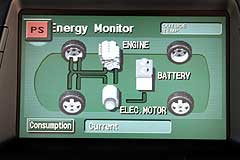
The 2004 Prius is a big improvement in every way over the previous model. The 2004 Prius offers a good ride, comfortable interior, reasonable performance and because of the level of content, it is a good value for the money. Its now a mainstream economy vehicle - and then some - and you’ll sleep better at night knowing you’ve done something good for the environment and helped the United Stated reduce its dependence on foreign oil.
This car is the darling of some of the Hollywood elite; those who are environmentally conscious. The old Prius repeatedly won NewCarBuyingGuide.com’s award for best Eco car. We are are quite sure it will be again this year. Next year may be a different story however as several new hybrids come on the market from other manufacturers. Our only regret: we wish the exterior design was a tad more mainstream.
Pros: Good value for the money. As good gas mileage as you’re going to get unless you drive a GEM, or a golf cart. Good interior appointments for an economy car.
Cons: Still a little goofy looking.
Ratings (1-10)
- Style: 8
- Performance: 7
- Price: 8
- Handling: 8
- Ride: 7
- Comfort: 7
- Quality: 8
- *Overall: 7.6
More Data
Where Built: Motomachi Plant in Toyota City, Japan
Major Options: Curtain/Side impact airbags, Smart Entry and Start, Navigation System, JBL 3-in-1 premium audio system with 6-disc CD changer, Vehicle Stability Control (VSC).
Seating: 5
Number of Rows: 2
Length in Inches: 175
Warranties: 3-year/36,000-mile Comprehensive, 5-year/60,000-mile Powertrain, 5-year/unlimited-mileage Corrosion Perforation, 8-year/100,000-mile Hybrid-related Component Coverage P>
Weight in Pounds: 2,890.
Maximum Payload in Pounds: Not Available.
Maximum Gross Vehicle Weigh in Pounds: Not Available
Towing Capacity in Pounds: Not Available.
Gas Tank Capacity in Gallons: 13.2
Destination Charge: $565




